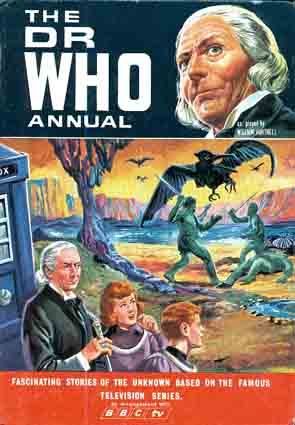The 1967 Annual

|
|
World Distributors The 1967 Annual |

|
| Illustrator | Walter Howarth |  |
| Published | 1966 |
| Starring the first Doctor |
A Review by Finn Clark 19/1/04
Oh dear. After a triumphant 1966 Dr Who Annual courtesy of David Whitaker, here we have something that's sadly far more representative of their output. In other words it's utter bollocks.
The stories have got shorter and sillier. The aliens are all high-concept... six-foot tall insects, carnivorous plants, Cyclops-like giants, the Devil Birds of Gorbo, etc. The various planets tend to be similarly dramatic: ice landscapes, underwater pirate hideouts and so forth. This was actually a feature of World Distributors' output over the years. Their stories usually had no characterisation, style, thematic depth or any other literary merit, so instead they tended to compensate with wild displays of imagination. Almost despite myself, I rather enjoyed that. If nothing else, these stories have considerable entertainment value. See Dr Who help the turkey people defeat a one-eyed giant from the Black Galaxy! Gasp as he shows off his egolectoscope (p17) and Zero Boots (p81)! Where else could you read lines like:
p54: "But I am sure it was no ordinary sword," he added. "It was some form of nuclear weapon."The stories are arranged intelligently. The best story (Ten Fathom Pirates) gets saved until last, with some classic Hartnell bluster as Dr Who outwits some slightly menacing underwater pirates. The collection also starts well, lulling one into a false expectations with The Cloud Exiles and The Sons of Grekk. They're vaguely stupid and silly, yes, but much less so than The Devil-Birds of Corbo. There's even some inter-story continuity, with a bunch of humans rescued from Corbo returning in The Playthings of Fo. [Yes, those humans include two children - Dot and Jack. Did you need to ask?]p66: "You are a very learned man, Doctor. I and my people - the Kaarks - will help you to recover your ship... I, the Kaark Supremo, have decreed it."
There are indications that the uncredited writer was either a Doctor Who fan or had read last year's annual. You'd think the Atmospheric Density Jacket was the Hartnell-era equivalent of the sonic screwdriver, while the Zarbi also get namechecked (as the annual wheels out its second consecutive batch of giant insects).
The plotting is poor even by the standards of this kind of nonsense. After inflicting upon us two sets of noise-sensitive aliens (the Voord and the Sensorites) in the 1966 annual, here we get two more! A couple of stories waste half their word count on a random travelogue of their alien environments. The Devil-Birds of Corbo is completely incoherent. The bad guy in Terror on Tiro is a disembodied megalomaniac called Klarimo and Dr Who's scheme for defeating him is... to help him return to his base?? ["Of course! It is a brilliant idea! Come, we must not delay."]
Most surreally, I have absolutely no clue how Dr Who kills the monster in The Playthings of Fo. It's not even an "I'll explain later" moment. One moment they're at the mercy of a giant that can hold the TARDIS in the palm of one hand, then suddenly he crashes lifeless to the ground because Dr Who put a black box on the ground and opened its lid. That's it. You think I'm kidding? This black box came from the TARDIS store-room, but what it is, what it does or how it does it... we don't learn. But there was a smell of ozone, so it must have been something clever.
However my all-time favourite is the switch with which Dr Who stops a robot rebellion in The Cloud Exiles. As the Ethereals break into the control room of the Baggolts... "There was a single switch on the master panel. It was set to 'Rebellion'. Dr Who wrenched it violently in the opposite direction. Now it was pointing to 'Peace'."
There's a six-page comic strip called Mission for Duh. Stop sniggering! It's actually quite enjoyable, though it demonstrates that Walter Howarth is better at illustrations than comic strips. The 1967 Dr Who Annual is funnier to think about than to read, but it's still pretty entertaining in a "check your brain at the door" kinda way. If you looked up "so bad it's good" in the dictionary, you'd find this.